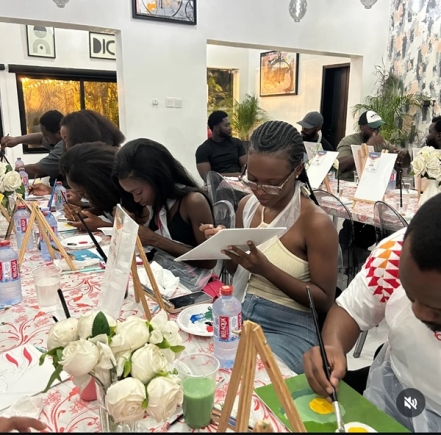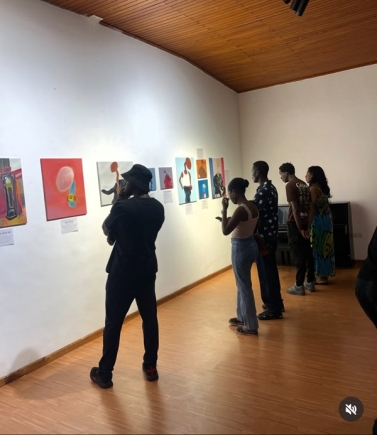Supporting stroke patients through art · The efforts of Dr Kwasi Aboryo Ankrah
While undertaking his housemanship at the University Hospital, Legon in Accra, Dr Kwasi Aboryo Ankrah noticed a gap in the care of patients who were admitted for stroke.
In most cases, people with the condition could not afford the cost of CT Scans in the early days of stroke. Sometimes it took about 72 hours for families to raise funds for ambulances and the cost of the scan which was then between GH₵600 to GH₵6500.
These delays, he realised, worsened the conditions of patients. It either contributed to long-term effects and sometimes death.
“We can't give them any type of treatment because we need to know whether it's a bleed that they are suffering from or whether it's a blockage of blood supply that they are suffering from.”
“We can't start treatment until we specify what type of stroke it is. So, the financial challenge with people not being able to afford CT scan diagnosis leaves them in the hospital bed sometimes 24-48 hours without any treatment,” he told The Mirror in an interview in Accra last Wednesday.
Dr Ankrah, commonly known as Boryo, decided to find ways to support families in such situations, starting a non-governmental organisation, Te-Apo, which literally means “get well” in Akan.
Also an artist, he chose to use art to tell stories of how strokes occur, its effects and also debunk myths on the condition which has become common in young people.

He explained that in the past, most of the patients diagnosed with stroke were above 50 years but lately, it was common to see people in their 30s and 40s with the condition.
In 2023, he held his first art exhibition and auction to raise funds to pay for the CT scans of stroke patients who couldn’t afford them.
Focused on using art for change, ahead of the exhibition, he held a social event, “Brushes N Minutes” where guests were led to paint art pieces. The aim was not only to raise funds to support his initiatives but to create awareness of stroke.

He also organised a couple of social events in Osu, Legon and Tse Addo all in Accra to whip up interest for the main exhibition held in October 2023.
His inaugural art show and auction, “Afasebiri” (purple, the colour for stroke awareness) was beyond just showcasing his talent but the pieces told stories and drummed home the importance of timely intervention in stroke treatment.
Proceeds from the sale of some of the art pieces were used as a seed for the Te-Apo Stroke Fund.
Boryo also organised another exhibition and auction, “Dompefy” in 2024 to continue his organisation’s mission to raise awareness of stroke.
In between his two solo exhibitions, he partnered the Global South Arts and Health Project where he made art pieces and sculptures, also focusing on stroke awareness and the challenges strokes come with.
Why art?
He explained that talking about stroke usually brought sad memories as the condition not only affected the quality of life of patients but also their families and close friends.
He said his approach was to provide a warm environment for people to learn more about the condition rather than telling just “sad stories”.

“We try as much as possible to make things fun and, you know, approach it from a progressive point. We are not just shedding light on the sorrows, but we are shedding light on the hope and on the possibilities if we come together as a community and support.”
“I also realised that I wasn't really feeding my gifts in art. I was spending much more time in the hospital and so I needed something serious to attach to the art that would force me to be more awake.
“Attaching the art to this cause means every year, I have to hold at least one art exhibition which means I have to paint. I have to make a lot of art pieces and then select the best from them for exhibition and hope to sell as many as I can to raise funds for the NGO. If I didn't start Te-Apo, I can go a year, two, three without touching a paintbrush because of how busy the job is and how life gets.
Boryo has other talents which complement his advocacy. For instance, for his first exhibition, he created theme music for the art pieces.
Art, music and making his events fun have worked for him as more young people follow his works.
Outreach events
Aside from his exhibitions, he has led a number of free health screening with the aim of picking up risk factors for stroke.
“We are trying to find individuals that, by the nature of their jobs or by the nature of their diet or age groups, are at risk of developing a stroke.”
“We check for these risk factors like high blood sugar, high cholesterol, high blood pressure, obesity, etc.”
“While we do the screening, we also counsel them and people who are found to be at a higher risk are referred for primary care so that they can be ahead of the stroke.”
“Over the next couple of years, we are hoping to gather a lot of data and then possibly publish a report so that the severity of the stroke crisis in Ghana will be made more obvious.

"Stroke is the number one cause of mortality and morbidity in Ghana, which basically means it's the number one cause of death but, nobody talks about it as much,” he explained.
He said while there are many risk factors which could lead to strokes, adding exercise to daily routines was one of the easiest ways to prevent stroke.
Sustainable financing model
For an organisation that started barely two years ago, Boryo and his team have been successful at most of their events.
For instance, for the first quarter of this year, donations made to the Stroke Fund could cover 50 plain CT scans for stroke patients who couldn’t afford them.
He said because most people did not know about the existence of the fund, they could not exhaust the allocated funds and still had more slots for free CT scans.
He is hoping to increase publicity on their work, get more people to support the cause and also find other ways to fund their activities since they could not depend on donations and art sales only.
Writer’s email: efiaamoakoa2@gmail.com
